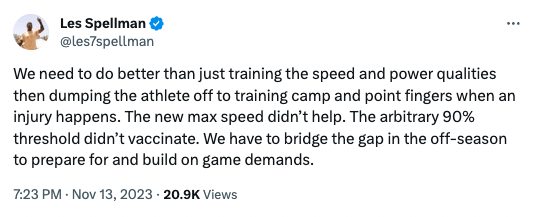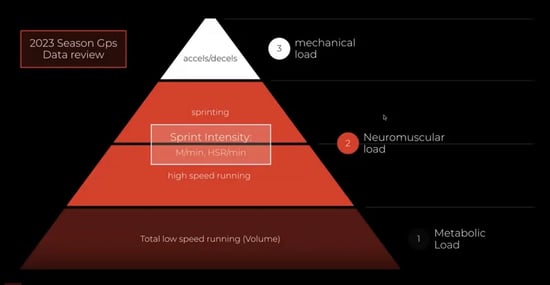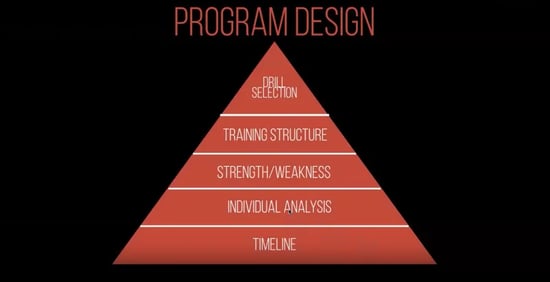Guide to Offseason Speed Training
You are more responsible for your team winning than you think
I want to make sure I drive this point home.
This should hit home for performance coaches, but if you’re a team sport coach that does speed/performance training within your practices, I’m talking to you too.
And believe me it took me a while to come around on this topic.
One of the biggest mistakes I've made as a coach has been building an offseason around making athletes faster and thinking that would directly transfer to their performance on field.
I'd do all the things. Acceleration Profiling, technical profiling, target loads with load velocity profile... ultimately handing off the athlete back to the team faster, stronger, and arrogantly believing I've just made a better performer.
If the goal was run a higher max velocity or run a 40 for testing that's probably the best outcome. The reality is, the data lies in the demands of the game. Tony Villani talks about "Game Speed" all the time.
I think we need to stop judging the success or failure of our program as an outcome like max speed or higher vertical. I’ve come to learn that we are more responsible for their on field play than we realize.

Breaking Down your Offseason Training
So, how do we do it? What should your offseason training look like? I’ll use football as an example and walk through what I do, and hopefully this will push you in the right direction.
There’s 3 sections I analyze when building an offseason plan:
- Game Analysis
- Individual Analysis
- Planning
Game Analysis
If I’m using football as an example, at the end of a season I’ll take a look back at every game broken down by these buckets:
Metabolic Load, Neuromuscular Load, and Mechanical Load. See image below:

By metabolic load, I mean overall volume. We use Catapult for this (check them out for a discount from us), but if you don’t have GPS you can just look at total time on the field.
Neuromuscular load is high speed running and then sprinting or “very” high speed running. These are thresholds typically set on a team to team basis, some would set high speed running at 75% of Max velocity, some 80%, etc.
Finally, mechanical load just means the number of accels and decels that an athlete has done. This includes joint loading, start stop, small areas, hard accels, hard decels.
From here, I’ll look over the course of a season what the difference between how the athletes train in practice vs what the actual game looks like. I broke this down in more detail on the webinar, but to summarize, there’s typically a gap in high speed exposure during practice.
Athletes aren’t hitting enough high speeds in practice in comparison to the game. The danger in this is that their is a large spike when it comes to game time.
So this is one area we know going into the offseason that we want to build a good chronic base for. Building the athletes ability to get the high speed distances they’ll need.
Individual Analysis
After game analysis comes the individual part.
I’ll do this by building force velocity profiles.
I typically put the athletes into four groups:
- High Force Deficient
- Low Force Deficient
- Low Velocity Deficient
- High Velocity Deficient
The point of this is to define what my training groups will be.
Within the groups, there will be a different training emphasis. Essentially we’ll be targeting where they are on their acceleration profile and then giving them an intervention specific to what quality they need work on.
Here’s a video of me talking a little bit more about FVP, or you can learn the in depth process in my digital course: Art of Acceleration.
Planning
We’re finally at the planning period. I think this is where a lot of coaches get mixed up. They start building a plan first before looking at the data.
When planning, I use the following pyramid:

- Timeline - where are we in the year? How much time do we have?
- Individual Analysis - Grouping the athletes
- Strength and Weaknesses - This will help us determined what their workflow will be in the coming weeks
- Training structure - more of the weekly plan
- Drill Selection - what drills are we adding in?
I see drills posted on social media all the time which is great, but often times there isn’t any context included. We select the drills last for a reason. Everything below it matters and plays a role into the drills we’re adding in which gets lost on social posts a lot of the time.
What does this mean?
All the information above is the base to any offseason program. From here, we apply this into our timeline broken into early offseason, late offseason, and pre season. Once the schedule/plan is in place, we build the workflow.
Honestly, a lot of it ties together. It can be simple if you start with the base and let everything else come from it.
But ultimately it comes down to the mistake I made early in my career that I talked about at the beginning.
If you don’t prepare them for the game, it doesn't matter their bench, their vertical, their 40 time or their top speed. They will not perform.
For Brandon Aiyuk’s offseason this year, our goal was entirely based on increasing high speed volume. Would it be nice if he got faster? Yes, but we didn’t red line things to make that a reality.
You are more responsible for your team winning than you think
P.S. If you want to learn how to build this system in your own training environment, check out our digital speed courses.